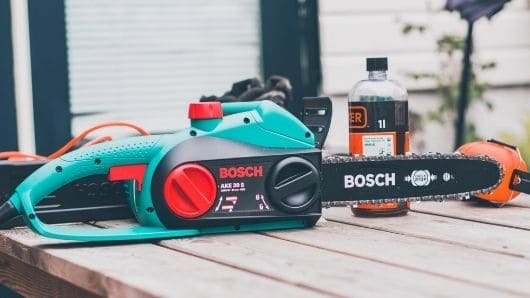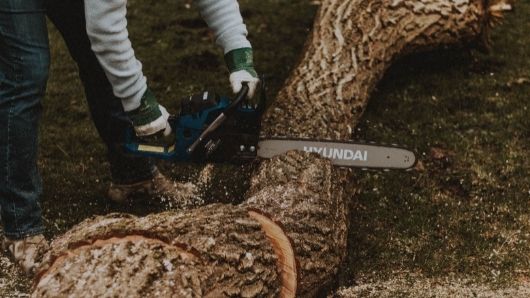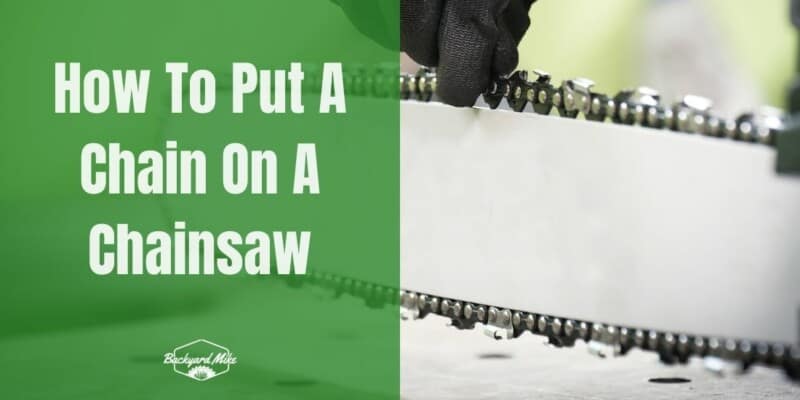If you’re having a hard time reattaching a chain to the chain bar, you’ve come to the right place.
You might be tempted to call a mechanic or buy a new chain. However, these are less convenient options and both would cost you money.
Worry no more as we’ll walk you through the process of putting a chain on a chainsaw. Follow the step-by-step guide below and get ready to be cutting wood in no time!
Why Do I Need to Readjust or Replace A Chain?
All power tools need proper care and maintenance. Look for the following signs to see if it’s time to readjust or replace your chainsaw chain:
- Over time, some bar screws are loosened. This affects the chain tension. Before using your saw, you need to do some readjustments to avoid damaging the chainsaw.
- If a wood chip falls in between the cracks and gets stuck in the chainsaw blade or around the housing, the bar and chain need to be cleared of this stubble.
- When heavily used, the heat from the motor extends to the bar which causes the chains to loosen up over time.
- If your saw chain is too old or too rusty, it may be time to change it. The type of cutting activities, maintenance, and use of the chainsaw affect the lifespan of the chain. Generally, a good quality chainsaw chain should last for about 3-5 years.
5 Simple Steps To Properly Put A Chain On A Saw Bar
We’ve narrowed the procedure to 5 simple steps to achieve a successful chain replacement.
What You’ll Need
- ½ inch Wrench
- Drift
- Medium-sized brush with soft bristles
- Medium-sized hammer
- Oil
- Cardboard or newspaper
- Gloves
Pre-Step Requirement
Before you start, it’s important to prepare and clear your work area.
Take out your cardboard or newspaper and spread this over your working table. Don’t skip this step to avoid losing or misplacing any parts of the chainsaw.
Step 1: Disassemble
- Place the chainsaw over the cardboard and remove the bar screws and housing.
- Start by using your wrench to unscrew the upper bar and lower bar nuts.
- Afterward, you need to loosen the tension screw to remove the chain. Use the slotted end of the wrench to do this. Set the screws aside then remove the cover or casing.
Step 2: Dust Off and Reapply Oil

Once you have your chainsaw open, take this opportunity to clean your chainsaw bar.
- Grab the brush and remove saw dust particles stuck in the corners and nooks of the machine.
- Apply a moderate amount of oil near the motor and blade. You also need to lightly grease the chains if you will be putting back a used chain.
Step 3: Mount the Chain in the Sprocket
It’s now time to place the chain on the blade. Before you attempt to put the chain in place, double-check that you have the right direction of the chain.
We don’t want any accidents, would we?
One slip-up and all the effort you’ve put in goes down the drain. Above all, we don’t want that to happen to you, so DOUBLE-CHECK first.
Chainsaw Chain Direction
Determining the right direction of the chains is a crucial part.
HERE’S WHAT YOU NEED TO REMEMBER: the teeth of the chains should face away from you.
All chainsaws have the same chainsaw blade direction. Chainsaw blades ALWAYS rotate clockwise (from left to right).
If you are holding the chainsaw, the direction of the blade is moving away from you. The chains should be facing the same direction.
Once you have determined the proper positioning of the chain, place it on top of the blade. Adjust it accordingly so that it meets the grooves of the bar.
Locate the tension stud in the chain and align it with the guide hole.
Step 4: Adjust Chain Tension
Locate the tensioning screw to adjust tension. You don’t want to use the chainsaw with a loosely or tightly wound chain.
How do I know the ideal tension?
The ideal chain tension is when the drive links ARE STILL engaged once pulled. Check if it can be lifted off up to one-fourth of an inch away from the bar.
Once you’ve achieved the proper level, put everything back together. Take the housing cover and firmly screw the bolts in place.
Do a final check and adjust the tension screw if necessary.
Final Step: Test the Chainsaw

Before wrapping up your tools and work area, do a few test runs on the chainsaw.
- Check if the tension is not too tight or too loose.
- Double-check if the chain moves well with the bar and if it moves in the right direction.
- Try turning it off and back on to see if everything works fine as before. The chainsaw should be able to cut through the practice wood with ease.
If it works just as well, CONGRATULATIONS! You’ve managed to put a chain on the chainsaw on your own.
How to Check If Your Chain Is Moving in the Right Direction
It’s a good practice to always do the three-way check after making any changes or adjustments to the chainsaw. What’s the three-way check, you may ask?
The three-way check is designed to help you determine if the chain has the CORRECT blade direction. You can choose to do just one or all three steps.
Top View Check
- Position your chain in a way you are looking down on it to give you a top view angle.
- Once you are holding your chainsaw, check the direction of the chain.
- Since the bar rotates clockwise, the sharp edges MUST face the same direction. In short, the blades or sharp edges should be pointing away from you and the chainsaw engine.
Front View Check
- Check the movement of the chain from the front; you should be seeing a downward movement.
- Observe where the sharp edges of the chain point to – the blades should point to the right.
- If it moves upward and the blades are pointing to the left, you’d have to do the process all over again.
Bottom View Check
- If you look at your chainsaw from below, the chain should be moving towards the motor or chainsaw body of the chainsaw.
Ready, Chain, Go!
That ends our guide on how to replace your saw chain.
- Remember to double-check the screws and tension before using the chainsaw.
- Make sure that your chain is set to move in the right direction to avoid any issues with your power tool.
- Do regular checkups on your chainsaw to prolong the lifespan of your cutting buddy.
We hope this tutorial helped. Let us know your thoughts by leaving a comment below. Thanks for reading!


